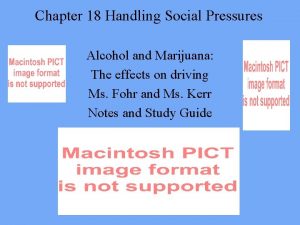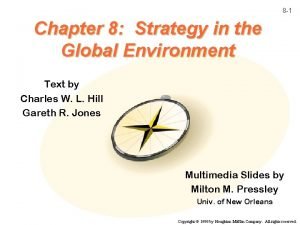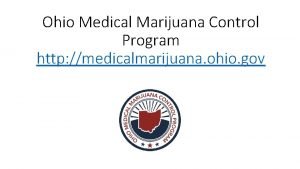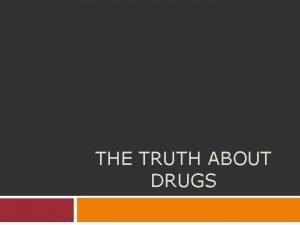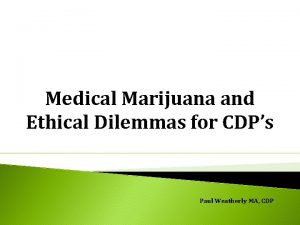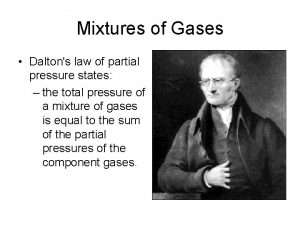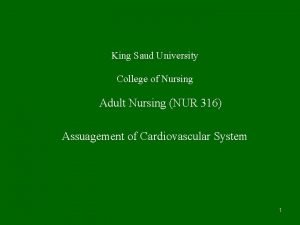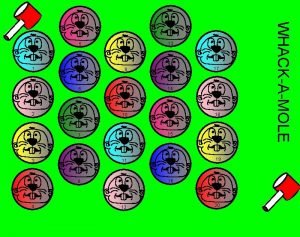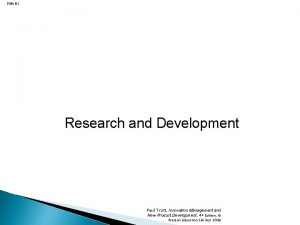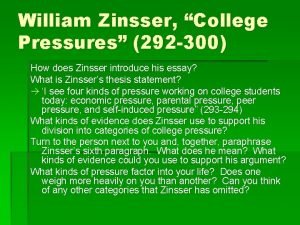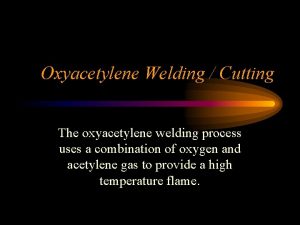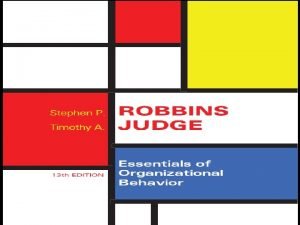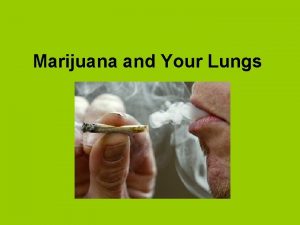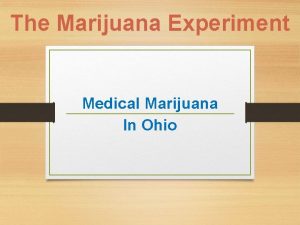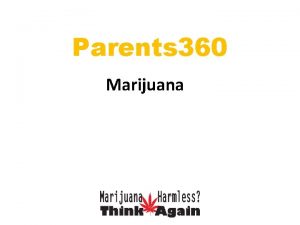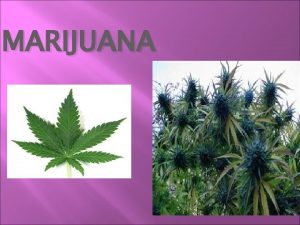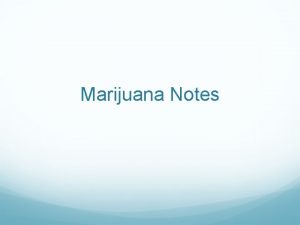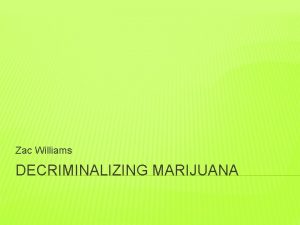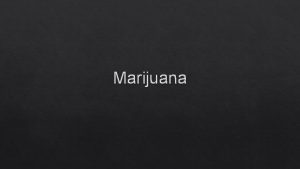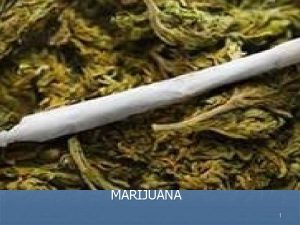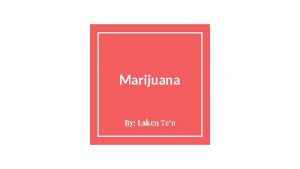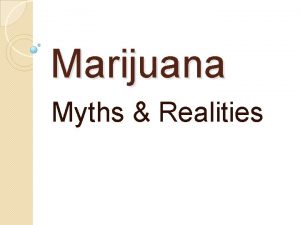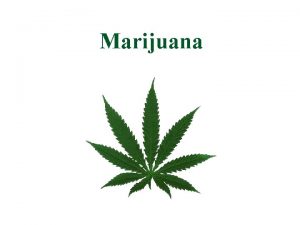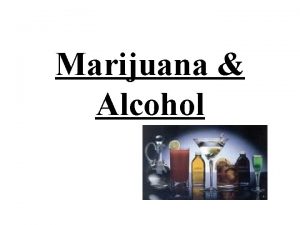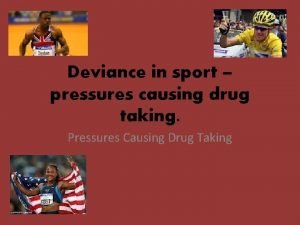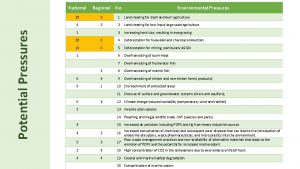Chapter 18 Handling Social Pressures Alcohol and Marijuana


















- Slides: 18

Chapter 18 Handling Social Pressures Alcohol and Marijuana: The effects on driving Ms. Fohr and Ms. Kerr Notes and Study Guide

Depressants Are drugs that slow down the central nervous system (brain and spinal column) and body reactions. Drinking too much alcohol shuts down the brain and a person can pass out or go into a coma or even worse die.

Alcohol • Is a chemical that causes a change in a person’s body and appearance. • Ethanol is the alcohol found in beverages such as beer, wine and hard liquor.

What is Alcohol? • Legal to consume if 21 years old or older, illegal to consume if under the age of 21. • Beer - 3 -6% is alcohol is fermented from grains, barely, corn, rye or hops. • Wine - 12 -14% is alcohol is fermented from grapes or other fruits. • Liquor - 40 -50% is alcohol is distilled made from grains, fruits, rice or vegetables. • A drink’s “proof” is twice as high as its actual alcohol content. So a 80 -proof liquor is really composed of 40% alcohol.

Comparing types of Alcohol • Beer - 12 ounces • Wine - 5 ounces • Hard liquor (a shot) - 1 1/2 ounces • These all equal a legal drink in New Jersey.

Alcohol and digestion • The body does not digest alcohol like food. • The liver can only metabolize 1/2 ounce of pure alcohol per hour, which is turned into water. Scar tissue that damages the liver is called cirrhosis. • 20% of alcohol enters the bloodstream through the walls of the stomach. • Alcohol is high in calories and has no nutritional value. • 4, 000 people die each year as a result of alcohol poisoning, drinking too fast and/or too much. • Social drinking in moderation can provide health benefits.

Some of the effects of alcohol Alcohol may cause confusion, decreased alertness, slowed reaction time, poor coordination, blurred vision, and drowsiness. The brain, liver and kidneys may become damaged from drinking alcohol.

Intoxication refers to the many negative effects alcohol has on a drinker's body and behavior. Blackouts are periods of time that the drinker cannot recall. Hangover is the term for physical symptoms such as nausea, headache and sensitivity to light from drinking too much alcohol.

Blood alcohol concentration Is the amount of ethanol alcohol in a person' s blood is expressed by a percentage. BAC measures the number of milligrams of ethanol per 100 milliliters of blood A BAC of 0. 1 percent means that 1/10 of 1 percent of the fluid in the blood is ethanol. YOU ARE LEGALLY DRUNK IN NEW JERSEY WITH A. 08% BAC.

Factors that affect a person's Blood Alcohol Concentration • Gender • Age • Amount of food in eaten • Amount of alcohol consumed • Body weight and/or percent body fat • Speed at which alcohol is consumed • Presence of other drugs in the bloodstream Testing for BAC can be done by breathalyzer, blood or urine tests.

DRINKING AND DRIVING • About 12, 000 teenagers die in drunk-driving car crashes each year. • That averages to 33 young people every day. • Alcohol is the most widely abused drug of high school students. • Over 1/2 of young driver involved in alcohol related crashes have a BAC of. 02%. • Of all fatal car accidents, about 50% involve alcohol.

ALCOHOL AND DECISIONS • Only time without drinking can sober a person up. • The greatest number of people arrested for DWI were drinking beer. • Alcohol does depresses the central nervous system, but all people do not react the same way, some get violent, some funny but all will have a slower reaction time, reduced coordination, loss of common sense and take more risks.

Marijuana • It can be classified as a depressant, stimulant or hallucinogenic drug, it depends on the amount of THC (the main ingredient which is very powerful, the more THC the more a person will hallucinate). • The average amount of THC is normally 3 %, the active ingredients of the leaves; stems and flowers pass through the lungs when smoked.

Marijuana Facts • • • Derived from the hemp plant. THC is absorbed in fatty tissues in the body. Traces can be found for weeks in urine tests. When smoked produce over 400 chemicals. All forms are mind-altering. Smoking affects the brain which reduced coordination, alertness, and reaction time. • Mixed with cigars it is called a blunt. • Cannabis is referred to marijuana and other drugs from the hemp plant. • Yes, it does contain cancer causing toxins, over 400 different chemicals.

Marijuana- The most widely abused illegal drug in the world. • Short term or immediate effects include impaired short-term memory, attention, slowed reaction time, judgment, coordination, balance, increased heart rate, bloodshot eyes. The user may feel thirsty and hungry when using pot. • Long-term effects can lead to addiction, paranoia, anxiety, learning and memory difficulties as well as a weakened respiratory and immune system.

Stimulants - Are drugs that speed up activities of the central nervous system. These drugs increase heart rate, blood pressure, and breathing rate and constrict pupils of the user. Hallucinogens - Are drugs that altar perception, thought and mood. They have no medical uses. The user often sees colorful visions and feel like they have superhuman powers.

Inhalants • Any household product (glue, hair spray, cleaning fluids, paint thinner, gasoline) that is inhaled through the nose that produces a desired effect. • Inhalant users are also at risk for Sudden Sniffing Death (SSD), which can occur when the inhaled fumes take the place of oxygen in the lungs and central nervous system. • This basically causes the inhalant user to suffocate. Nosebleeds, nausea, slurred speech, headaches, loss of smell and brain damage are some common side effects.

ALL DRUGS • Because of their strength and potential for harm the FDA has put labels on prescription medicines, over-the-counter medicines and alcohol products that operating a motor vehicle may cause harm to you and others. • Always drive with a clear head and sound body. Do don’t drive after taking any type of drugs.
 Chapter 18 handling social pressures
Chapter 18 handling social pressures Cost pressures and pressures for local responsiveness
Cost pressures and pressures for local responsiveness What is secondary alcohol
What is secondary alcohol Primary alcohol oxidation
Primary alcohol oxidation Brown weeds
Brown weeds Ohio medical marijuana day supply chart
Ohio medical marijuana day supply chart Became marijuana state
Became marijuana state Should marijuana be a medical option
Should marijuana be a medical option Lungs marijuana
Lungs marijuana Marijuana names
Marijuana names Medical marijuana ethics
Medical marijuana ethics 410a suction pressure chart
410a suction pressure chart Partial pressure gas law
Partial pressure gas law Heart chamber pressures
Heart chamber pressures Pronatalist pressure
Pronatalist pressure Paul trott
Paul trott College pressures by william zinsser
College pressures by william zinsser An acetylene hose nut ____.
An acetylene hose nut ____. Responding to economic pressures in ob
Responding to economic pressures in ob
